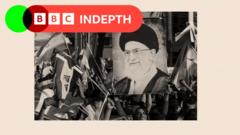In a dramatic shift in U.S. policy, President Trump has greenlit military strikes on Iranian nuclear sites, crossing a line that has long been avoided by his predecessors. This move represents a significant escalation in the decades-long tension between the United States and Iran, both wary of descending into a full-blown conflict. The stakes are amplified as Iran’s supreme leader, Ayatollah Ali Khamenei, faces the daunting task of determining Iran's next steps while holed up amid mounting pressure.
Khamenei, now 86, has traditionally navigated a cautious strategy to safeguard the Islamic Republic’s interests. However, he finds himself at a critical juncture where inertia could be perceived as weakness, and aggression could invite severe reprisals. Sanam Vakil from Chatham House notes that Khamenei's decisions could shape his legacy profoundly.
The backdrop of this escalated tension includes a heightened campaign from Israel, which has already inflicted significant damage on Iran’s military hierarchy and capabilities through targeted strikes. Analysts suggest that Iran, while vocally opposing U.S. incursions, is likely considering its response carefully to avoid catastrophic miscalculations, particularly with America maintaining substantial troop presence in the region.
As the situation unfolds, the Iranian leadership grapples with whether to respond militarily to U.S. strikes—risking a strong U.S. counterstrike—or to exercise restraint amid claims of lost prestige and regional authority. This precarious balance has been exemplified in the past, notably during the assassination of Iranian commander Qasem Soleimani, where Iran retaliated without escalating further conflict.
As President Trump endorses aggressive tactics against Tehran, the Iranian government regards diplomatic overtures as veiled threats rather than authentic reconciliations. The complexities of the situation are compounded by a divided European stance that simultaneously pressures Iran to curb its uranium enrichment while advocating for mediation rather than military interventions.
This entanglement of diplomatic failure and military aggression leads observers to question whether the prospect of nuclear proliferation in Iran has actually increased following intensified hostilities. With no clear resolution in sight, the unfolding events significantly increase the risks posed both to regional stability and to the broader geopolitical landscape. As Trump finds himself pulled in different directions by domestic and foreign pressures, the future of U.S.-Iran relations is more uncertain than ever.



















